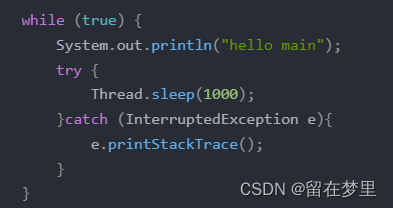⭐在操作系统中运行的程序就是进程,比如说QQ,播放器,游戏等等…程序是指令和数据的有序集合,其本身没有任何运行的含义,是一个静态的概念.
⭐进程和线程都是为了处理并发编程这样的场景,但是进程有问题,频繁拆功创建和释放资源的时候效率低,相比之下,线程更轻量,创建和释放效率更高.
⭐进程具有独立性,每个进程有各自独立的虚拟地址空间,一个进程挂了,不会影响其他进程,同一个进程中的多个线程,共用同一个内存空间,一个线程挂了,可能影响其他的线程,甚至导致整个进程崩溃…
⭐而进程则是执行程序的一次执行过程,他是一个动态的概念,是系统资源分配的单位
⭐通常在一个进程中可以包含多个线程(如果把进程想象成一个工厂,那么线程就是工厂里的生产线,一个工厂里面面可以有一个生产线,也可以有多个生产线),当然一个进程中至少一个线程,不然没有存在的意义,线程是CPU调度和执行的单位.
⭐真正的多线程是指有多个CPU,即多核.
⭐线程就是独立执行的路径
⭐在程序执行时,即使没有自己创建线程,后台也会有多个线程,如主线程,GC线程.
⭐每个线程在自己的工作内存交互,内存操控不当会造成数据不一致.
1.先描述一个进程.(明确除一个进程上面的一些相关属性)
2.在组织若干个进程.(使用一些数据结构,把很多描述进程的信息放到一起,方便进行增删查改,典型的实现,就是使用双向链表把每个进程的PCB串起来).
并行:微观上,两个CPU核心,同步你是执行两个任务的代码.
并发:微观上,一个CPU核心,先执行一会任务1,在执行一会任务2,在执行一会儿任务3,只要切换足够快,宏观上看起来,就好像很多任务同时执行一样,
并发和并行,只有在微观上可以区分,宏观上区分不了,微观上这里的区分都是都是操作西欧统自动调度的结果.正因为供观赏区分不了并行和并发,在写代码的时候不去区分,只是在研究操作系统进程调度的时候稍做区分,其它场景基本都是使用并发作为一个统称来代替.
方法一: 通过Thread类创建线程,这是最简单的方法,创建子类,继承Thread类,并重写run方法.
package thread;
class MyThread extends Thread{
@Override
public void run() {
System.out.println("hello thread");
}
}
public class Demo1 {
public static void main(String[] args) {
Thread t = new MyThread();
t.start();
}
}
方法二:
import java.util.Scanner;
class MyThread2 extends Thread{
@Override
public void run() {
System.out.println("hello thread!");
try {
Thread.sleep(1000);
}catch (InterruptedException e){
e.printStackTrace();
}
}
}
public class Demo2 {
public static void main1(String[] args) {
Thread t = new MyThread2();
t.start();
while (true) {
System.out.println("hello main!");
try {
Thread.sleep(1000);
}catch (InterruptedException e){
e.printStackTrace();
}
}
}方法三: 创建一个匿名内部类,继承自Thread类,同时重写run方法,同时再new出这个匿名内部类的实例.
import java.util.*;
class MyRunnable implements Runnable {
@Override
public void run() {
System.out.println("hello!");
}
}
public class Demo3 {
public static void main1(String[] args) {
Thread t = new Thread(new MyRunnable());
t.start();
}方法四: 同样使用了匿名内部类.
public class Demo4 {
public static void main(String[] args) {
Thread t = new Thread(){
@Override
public void run() {
System.out.println("hello thread");
}
};
t.start();
}
}方法五: 使用了lambda表达式.
import java.util.*;
public class Demo5 {
public static void main1(String[] args) {
Thread t = new Thread(new Runnable() {
@Override
public void run() {
System.out.println("hello thread");
}
});
t.start();
}public class Demo7 {
private static final long count = 10_0000_0000;
public static void serial(){
//吉利程序执行时间
long beg = System.currentTimeMillis();
long a = 0;
for (int i = 0; i < count; i++) {
a++;
}
long b = 0;
for (int i = 0; i < count; i++) {
b++;
}
long end = System.currentTimeMillis();
System.out.println("消耗时间: "+ (end - beg) + "ms");
}
public static void concurrency() throws InterruptedException {
long beg = System.currentTimeMillis();
Thread t1 = new Thread(()->{
long a = 0;
for (int i = 0; i < count; i++) {
a++;
}
});
t1.start();
Thread t2 = new Thread(()->{
long b = 0;
for (int i = 0; i < count; i++) {
b++;
}
});
t2.start();
//此处布恩那个直接记录结束时间,别忘了,现在这个时间戳的代码是在main 线程中
//main t1 t2 是并发执行关系,此处t1 t2 还没执行完呢,这里就开始记录结束时间了,这显然是不准确的.
//正确做法应该是让main线程等地啊t1 t2跑完了,在记录结束时间
//join 效果就是等待线程结束,t1.join 就是让main 线程等待 t1 结束,t2.join让main 线程等待t2结束
t1.join();
t2.join();
long end = System.currentTimeMillis();
System.out.println("消耗时间: "+ (end - beg)+ "ms");
}
public static void main(String[] args)throws InterruptedException {
// serial();
concurrency();
}
}1.start
决定了系统中是不是真的创建出线程,run单纯的是一个普通的方法,描述了任务的内容,start则是一个特殊的方法,内部会在系统中创建线程.

public class Demo9 {
public static void main(String[] args) {
Thread t = new Thread(()->{
while (true) {
System.out.println("hello thread1");
try {
Thread.sleep(1000);
}catch (InterruptedException e){
e.printStackTrace();
}
}
});
t.start();
//t.run();
while (true) {
System.out.println("hello main");
try {
Thread.sleep(1000);
}catch (InterruptedException e){
e.printStackTrace();
}
}
}
}run方法只是一个普通的方法,在main线程里面调用run,其实并没有创建线程,这个循环仍是在main中执行的.

中断线程:让一个线程停下来.
线程停下来的关键,是要让对应的run方法执行完.
(1).可以手动设置一个标志位,来控制线程是否要执行结束.
public class Demo10 {
private static boolean isQuit = false;
public static void main(String[] args) {
Thread t = new Thread(()->{
while (!isQuit) {
System.out.println("hello thread");
try {
Thread.sleep(1000);
}catch (InterruptedException e){
e.printStackTrace();
}
}
});
t.start();
//只要把这个isQuit 设为true ,此时这个循环就退出了,进一步run 就执行完了,再进一步就是线程结束了
try{
Thread.sleep(5000);
}catch (InterruptedException e){
e.printStackTrace();
}
isQuit = true;
System.out.println("终止t线程");
}
}(2).使用thread中内置的一个标志位来进行判定.
public class Demo11 {
public static void main(String[] args) {
Thread t = new Thread(()->{
while(!Thread.currentThread().isInterrupted()){
System.out.println("hello thread");
try {
Thread.sleep(1000);
}catch (InterruptedException e){
e.printStackTrace();
//当触发异常之后,立即就退出循环
break;
}
}
});
t.start();
try{
Thread.sleep(5000);
}catch (InterruptedException e){
e.printStackTrace();
}
//在线程中 调用interrupt 方法 来终端这个线程
//t.interrupt 的意思是让t线程被中断!!
t.interrupt();
}
}多个线程之间,调度顺序是不确定的,线程之间的执行是按照调度器来安排的,这个过程可以视为无序或者随机的,有些时候,我们需要控制线程的顺序,线程等待就是其中一种手段,此处的线程等,主要控制线程结束的先后顺.
join: 调用join的时候,那个线程调用的join,那个线程就会阻塞等待,等到对应的线程执行完毕为止(对应线程的run执行完).
public class Demo12 {
public static void main(String[] args) {
Thread t = new Thread(()->{
for (int i = 0; i < 5; i++) {
System.out.println("hello thread");
try{
Thread.sleep(1000);
}catch (InterruptedException e){
e.printStackTrace();
}
}
});
t.start();
//在主线程中可以使用一个等待操作,来等待t线程执行结束
try{
t.join(10000);
}catch (InterruptedException e){
e.printStackTrace();
}
}
}
如果线程调用了sleep方法,这个PCB就会进入到阻塞队列.
当睡眠时间到了,系统就会把这个PCB从阻塞队列挪回到就绪队列.
实例:
public class Demo14 {
public static void main(String[] args) throws InterruptedException {
Thread t = new Thread(()->{
while (true) {
//z这里啥都不能有
try{
Thread.sleep(1000);
}catch (InterruptedException e){
e.printStackTrace();
}
}
});
t.start();
Thread.sleep(1000);
System.out.println(t.getState());
}
}